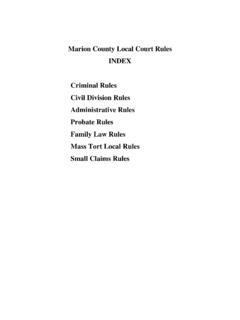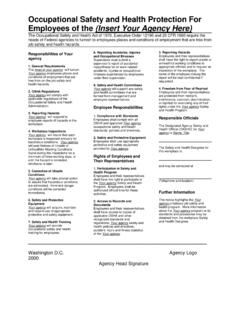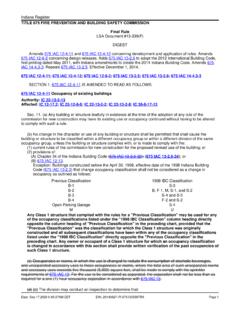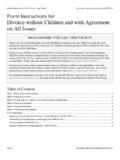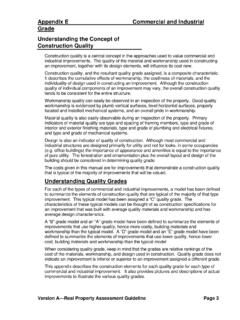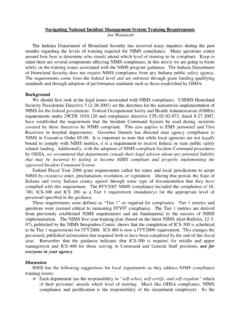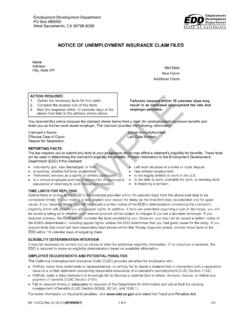Transcription of 1 Page Revised: 2/28/2022 - Indiana
1 1 | Page Revised: 12/22/2021 2 | Page Contents DWD CONTACT INFORMATION .. 7 unemployment insurance EMPLOYER HANDBOOK .. 7 UI at a Glance .. 8 INTRODUCTION TO unemployment insurance .. 9 UI In General .. 9 Federal unemployment Tax Act (FUTA) Code Title 26, Subtitle C, Chapter 23 .. 9 State unemployment Tax Act (SUTA) Indiana Code Title 22 Article 4 .. 9 Federal Certification .. 10 Employer Method of Payment for State unemployment Taxes .. 10 GETTING STARTED .. 12 Employer Qualifications .. 12 Definition of Employer .. 12 Regular Business Entity (Ind. Code 22-4-7 -1) .. 13 Complete Acquirer (Ind. Code 22-4 -7 -2(a)) .. 13 Partial Acquirer (Ind. Code 22-4 -7 -2(b)) .. 13 FUTA Liable Entity (Ind. Code 22-4 -7 -2(f)) .. 13 Exempt Entity that wants to Voluntarily Elect to extend the Act (Ind. Code 22-4-7 -2(d)) .. 13 Agricultural Entity (Ind. Code 22-4 -7 -2(e)).
2 14 Governmental Entity (Ind. Code 22-4 -7-2(g))* .. 14 Not-for-Profit (501(c)(3)) Entity (Ind. Code 22-4 -7 -2(h))* .. 15 Individual or College Fraternal entity with persons engaged to perform domestic services (Ind. Code 22-4-7 -2(i)) .. 15 PEO Professional Employer Organization (Ind. Code 22-4 ) .. 15 Employee Classification .. 16 Multi-State Employment .. 17 Wage Base Credits .. 18 Employer Registration .. 19 E S S Browser Issues .. 20 Required Posters .. 21 New Hire Reporting/Preventing Fraud .. 22 Why is new hire reporting important?.. 22 How to report new hires .. 22 New Employer Premium Rate .. 22 Reimbursable Employers .. 23 Become a reimbursable employer by: .. 24 QUARTERLY EMPLOYER REPORTING .. 26 3 | Page Quarterly Reports .. 26 Reporting Payroll .. 27 Amending Quarterly Reporting .. 28 Covered Employers / Covered Employment .. 28 Quarterly Report Due Dates .. 29 Retroactive Payments .. 29 Paying the Amount Due .. 30 EFT / EDI using CCD+ or CTX 820.
3 34 E S S WAGE GUIDE .. 36 E S S Account Credentials .. 36 New Employer .. 36 Existing Employer .. 37 Account Recovery .. 38 Linking multiple SUTA Accounts to the Same User .. 38 Reporting: Using the E S S / UPLINK Web Application .. 39 Common Terms / Definitions used in Quarterly Reporting .. 39 Other Important Considerations .. 42 E S S / UPLINK Wage Reporting Error Messages .. 43 SPECIAL TYPES OF EMPLOYMENT AND PAYMENT .. 44 SEASONAL EMPLOYMENT .. 48 Qualifying as a Seasonal Employer .. 48 Loss of Seasonal Employer Status .. 49 BUYING, SELLING, TRANSFERRING, OR REORGANIZING A BUSINESS .. 50 Complete Transfer of Indiana Operations (Ind. Code 22-4 -7 -2(a)) .. 50 Partial Transfer of Indiana Operations (Ind. Code 22-4 -7 -2(b)) .. 52 DISSOLUTION, LIQUIDATION, WITHDRAWAL OF A BUSINESS .. 54 COLLECTION ACTIONS .. 55 Failure to pay Legal Actions .. 56 EMPLOYER EXPERIENCE ACCOUNTS .. 58 Employer Experience Account Components .. 58 Qualifications for UI Benefits.
4 59 Examples of Individuals NOT Eligible for UI Benefits .. 60 Workers Employed at a Business During a Short-Term Shutdown or Unpaid Vacation .. 61 Employees of Certain Head Start Programs Who are on Planned Breaks (such as summer vacation) .. 62 Employees Receiving a Voluntary Buyout .. 63 Deductible and Non-Deductible Income .. 63 Pension, Retirement, Annuity Distributions .. 63 4 | Page Severance, Vacation, and Holiday Pay .. 64 How a Former Employee s Benefit Claims are charged to an employer.. 64 How a Former Employee s Benefit Claims create an invoice for a reimbursable employer.. 64 Partial UI Benefits Paid to a Current, Former or Laid-Off Employee .. 64 Voluntarily Leaving Employment .. 65 Discharge for Just Cause .. 66 Gross Misconduct .. 66 Suspension of and Requalifying for Benefits .. 67 Mutualized Benefit Charges .. 67 STATE PREMIUM RATE COMPUTATION .. 68 How to Determine the Premium Rate .. 68 1. Determine the type of UI premium rate.
5 68 2. Determine the Employer experience rate ratio .. 69 3. Determine the Employer s premium rate from the applicable schedule .. 69 4. Determine the Applied Premium Rate .. 70 Voluntary Payments .. 72 Premium Rate Summary .. 73 WHAT TO EXPECT IF A FORMER EMPLOYEE FILES A CLAIM .. 74 Separating and Base Period Employer Notice .. 74 Reading and responding to the Base Period Separation Notice (SF52984) .. 76 Determination of Eligibility .. 77 Statement of Benefit Charges .. 77 Combined Wage Transfer .. 78 Filing an Appeal .. 78 Wage Investigation .. 78 Wage Data and other Confidential Information .. 79 STATE INFORMATION DATA EXCHANGE SYSTEM (SIDES) .. 80 What is SIDES .. 80 SIDES E-Response .. 80 UI SIDES .. 80 THE APPEALS PROCESS .. 81 Appeals .. 81 Benefit Eligibility Appeals .. 81 Recommended Documentation and Practices .. 82 Postponement of Hearings .. 82 Review Board Proceedings .. 82 Employer Liability Protests .. 83 5 | Page Proceedings before a Liability Administrative Law Judge (LALJ).
6 84 Indiana Court of Appeals .. 84 Reasonable Cause Waivers for Late Payment of Contribution or Reimbursement .. 85 Reasonable Cause Waivers for Penalty Merit Rates .. 86 MAINTAINING INTEGRITY IN THE unemployment insurance PROGRAM .. 88 Reporting New Hires .. 88 Why is new hire reporting important?.. 88 Report UI Fraud .. 88 Report Work Refusals .. 89 How to Report: .. 89 What is a Valid Job Offer? .. 89 Employer Audits .. 90 Employment Records .. 90 SUTA Dumping .. 91 Mandatory Transfers .. 91 Prohibited Transfers .. 91 Penalties for SUTA Dumping .. 91 Why SUTA Dumping is Harmful .. 91 FREQUENTLY ASKED QUESTIONS .. 93 What is unemployment insurance ? .. 93 Who pays unemployment insurance ? .. 93 Who is an Employer? .. 93 What is a Reimbursable Employer? What do they pay? .. 94 Who is an Employee? .. 94 What are Wages? .. 94 Who must register with the Indiana Department of Workforce Development (DWD)? .. 95 How do I register? .. 95 What will the organization s rate be?
7 What must the organization pay? .. 95 Do the organization s workers qualify for UI coverage EVEN if the organization does not qualify as an employer under the Act? .. 96 What records must the organization keep?.. 96 The business is a corporation, and the only employee is a corporate officer. Is the organization required to report the wages that the corporate officers earns from the corporation? .. 96 In what type of situation can the organization treat workers as independent contractors? .. 97 GLOSSARY .. 98 6 | Page 7 | Page DWD CONTACT INFORMATION General Questions: (800) 891-6499 and select the employer tax option Web Address: Email: unemployment insurance EMPLOYER HANDBOOK The unemployment insurance (UI) program is administered by the Indiana Department of Workforce Development (DWD). This guide helps employers understand how they are affected by the law governing the UI program in Indiana . This guide explains the following: How DWD opens and maintains an employer account; An employer s responsibilities if they cease or transfer operations; Employers premium obligations and merit ratings; The conditions under which former employees can collect UI benefits; An employer s responsibilities when a former employee files a claim for benefits; DWD s efforts to maintain program integrity and prevent fraud; The responsibilities of commonly owned, managed, and controlled entities; Special employment tax issues.
8 Please see the glossary for an explanation if a term is unfamiliar. DWD is governed under Title 22, Article 4 of the Indiana Code (IC 22 - 4). Wherever the handbook references the Act, it is a reference to IC 22 - 4. For copies of statutes and regulations relating to DWD, visit Pursuant to 20 CFR , please be advised that confidential claimant unemployment compensation information and employer wage information may be requested and utilized for other governmental purposes, including, but not limited to, verification of eligibility under other government programs. For the sake of clarity and consistency, the organization, trade, or business to which the Act applies is called the organization. The organization may refer to any entity, organization, employer, or employing unit whether covered under the Act or not. The employer is used to refer to a specific entity that has been determined to have liability for unemployment insurance coverage for their workforce in Indiana .
9 For compatibility with screen readers Employer Self-Service, ESS, is represented as E S S. This guide is for general information, not to cover all phases of law or to answer all questions. The Employer Handbook is a living document and will include changes from the US Congress and 8 | Page the Indiana General Assembly as they are finalized. UI at a Glance CLAIMANT: Maximum Weekly Benefit Amount: $390 Minimum Weekly Benefit Amount: $37 Benefit Length: 1-26 weeks (one week waiting period* per Benefit Year) *The waiting week requirement was suspended temporarily through the COVID relief and recovery period between March 4, 2020, and September 4, 2021. EMPLOYER: 2011 to 2021 Premiums are based on the first $9,500 of wages per employee per calendar year. Rate Type Rate Maximum cost per employee Minimum $ Typical New Employer $ Maximum in good standing $ Maximum delinquent rate $ 9 | Page INTRODUCTION TO unemployment insurance UI In General unemployment insurance is a collaborative federal-state program financed through mandatory employer payments into two separate trusts, one administered by the United States Department of Labor (U S D O L), and one administered by the State Workforce Agency, which in Indiana , is the Department of Workforce Development (DWD).
10 The program is jointly regulated under the Federal unemployment Tax Act (FUTA) and the State unemployment Tax Act (SUTA). The purpose of the unemployment insurance Program is to protect society from the deprivations caused by workers being unemployed through no fault of their own. The unemployment insurance program accomplishes this goal by providing short-term cash assistance to those workers who qualify for benefits. Federal unemployment Tax Act (FUTA) Code Title 26, Subtitle C, Chapter 23 The IRS collects FUTA taxes and requires covered employers to file a Form 940 each year, no later than January 31st for the prior calendar year s covered wages. The FUTA wage base is $7,000, meaning that employers pay tax on the first $7,000 in covered wages to each worker for each calendar year. If the employer has been determined to be a successor employer, the employer may take credit for wages paid by a predecessor in the same calendar year. The FUTA tax rate is Part of the collaboration between the federal and state programs allows any state that is fully compliant with FUTA requirements to receive a credit for their employers of up to This means that most employers have an effective tax rate of , or a maximum expense of $42 per year per worker.

